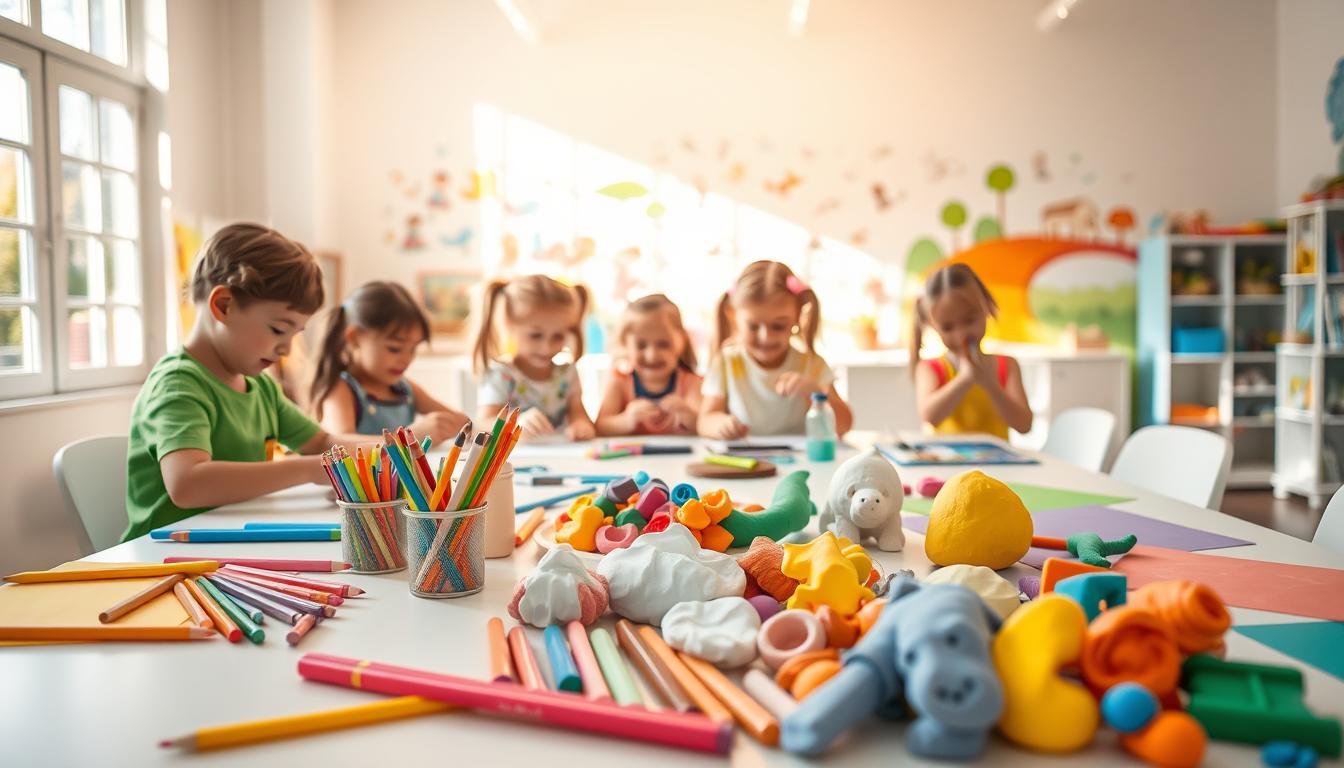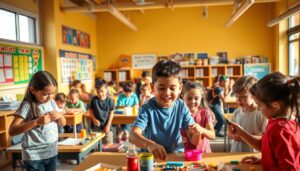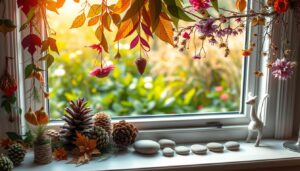Fun and Mess-Free Art Projects
“Every child is an artist. The problem is how to remain an artist once we grow up.” – Pablo Picasso’s words capture why creative expression matters. What if you could nurture that spark without chaos or costly supplies? Let’s explore how.
Imagine transforming everyday moments into creative adventures. Art With Trista’s 50 free activities, crafted from two decades of teaching, prove imagination thrives without mess. These ideas work anywhere – classrooms, kitchens, or backyards – using items you already own.
Parents and educators face real challenges: limited time, tight budgets, and cleanup fatigue. That’s why these solutions focus on joy over junk. Some require zero materials; others use basics like paper or sidewalk chalk. They’re perfect for hectic school days or lazy Saturdays.
Beyond fun, these methods build critical skills. Kids develop problem-solving abilities while mixing colors digitally. Fine motor skills grow through collage-making with leaves. Best part? You’ll spend more time creating than scrubbing tables.
Key Takeaways
- Access 50 free creative activities tested by educators
- Engage children without expensive supplies or cleanup stress
- Boost cognitive development through hands-on exploration
- Adapt ideas for classrooms, homes, or outdoor spaces
- Build confidence in young creators through achievable tasks
Introduction to Mess-Free Art Projects
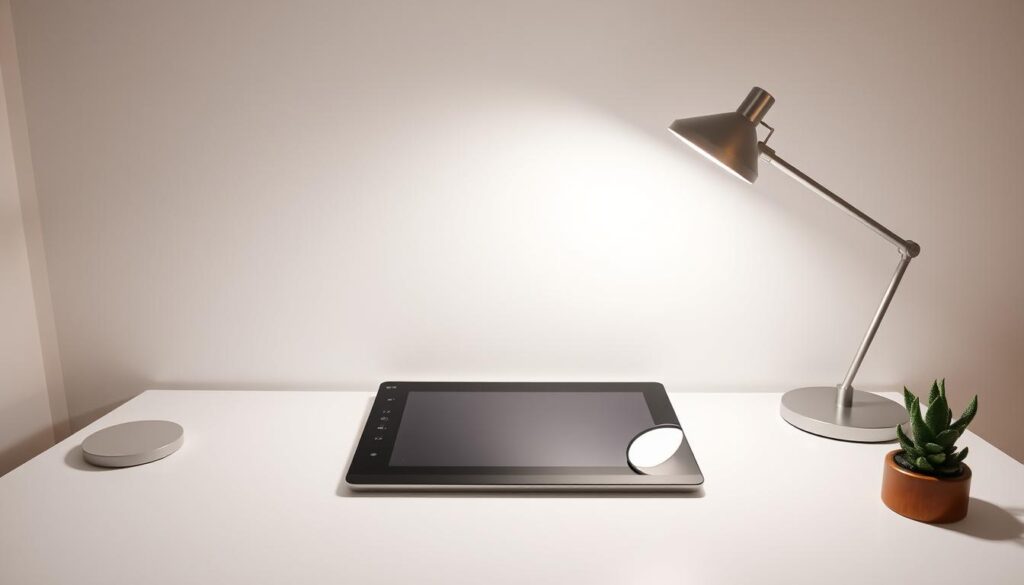
What if messy hands weren’t the price of creativity? The secret lies in strategic setups that let imaginations soar without leaving glitter trails. Mess-free activities thrive on simple swaps: think sticker collages instead of finger paints, or digital drawing apps over clay.
Setting the Stage for Creativity
Great experiences start with preparation. Clear a small table space or lay down a washable mat – this signals “creative zone” without rigid rules. Keep supplies like colored tape or chalk pastels within reach but organized. Kids focus better when tools feel intentional, not chaotic.
Process matters more than perfect results. When children mix virtual colors on tablets or arrange leaf patterns, they learn problem-solving through experimentation. Adults can guide by asking questions like “What happens if you flip that shape?” instead of directing outcomes.
Boundaries build confidence. A dedicated container for materials teaches responsibility, while timed sessions (20 minutes works well) maintain engagement. Rotate tools weekly – yesterday’s stickers become today’s stencils – to keep ideas fresh without new purchases.
Success comes from flexibility. Some days might involve tracing shadows with sticks; others could mean designing sock puppet characters digitally. The goal? Make creation feel like play, not a chore needing cleanup crews.
Benefits of Engaging in Art Projects
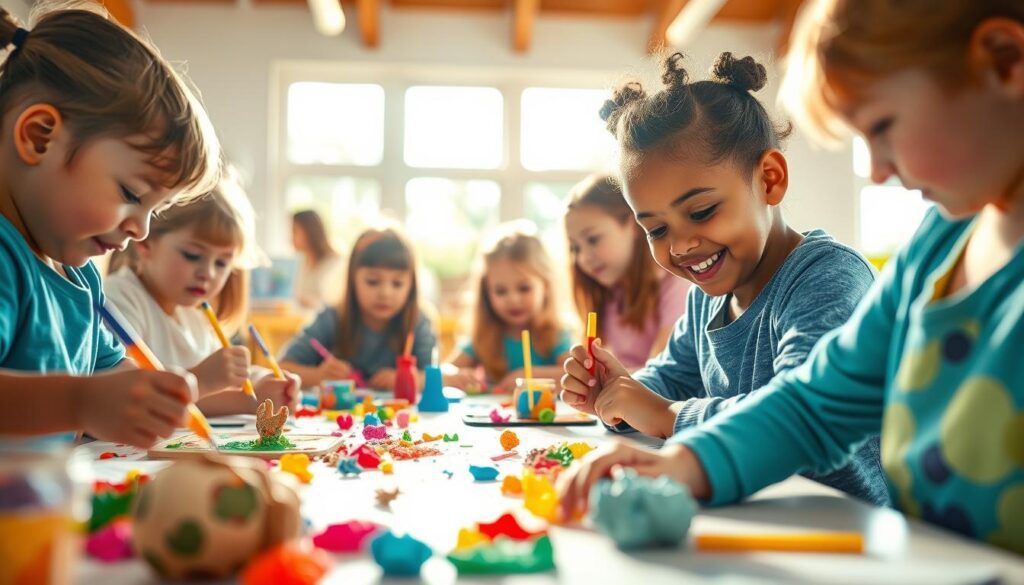
Creative activities do more than fill time—they shape young minds. Studies show children who participate in structured creative tasks develop stronger cognitive abilities and emotional resilience. Let’s explore how these experiences create lasting impacts.
Boosting Creativity and Focus
When kids mix colors or arrange shapes, their brains enter flow states. This deep focus builds attention spans better than many traditional learning methods. A child tracing patterns with stickers isn’t just playing—they’re training their mind to solve spatial puzzles.
Hands-on activities teach persistence. One teacher noted: “Students who struggled with math often excel at visual problem-solving through creative tasks.” These challenges adapt to different skill levels, keeping young learners engaged without frustration.
Building Confidence in Young Artists
Every finished piece becomes a victory. Displaying drawings or digital designs reinforces self-worth. Kids see their ideas matter—a crucial step in developing healthy self-expression.
Simple projects create big wins. A collage made from leaves teaches color theory. Digital apps let them undo mistakes, reducing fear of failure. Over time, these small successes build courage to tackle harder challenges.
| Activity Type | Skill Developed | Confidence Boost |
|---|---|---|
| Sticker Collages | Spatial Reasoning | Visible Progress |
| Digital Drawing | Tech Literacy | Error-Free Editing |
| Nature Patterns | Observation Skills | Natural Materials Mastery |
Parents often notice changes first. One shared: “My daughter now explains her ‘art choices’ like a museum curator!” This verbalization of creative decisions strengthens communication abilities too.
Essential Tips for Minimal Cleanup
Cleanup becomes effortless when creativity meets smart planning. The secret lies in pairing simple materials with intentional setups. Over 80% of mess-free success comes from smart choices made before the first marker cap pops off.
Choosing Mess-Free Materials
Start with tools that leave no trace. Washable markers vanish with water, while oil-based clay won’t crumble. Digital apps like Google Drawings let kids mix colors without spills. For paper-based work, try salt drawings on dark sheets – just shake off excess grains when done.
Sturdy materials prevent frustration. Thick paper handles heavy coloring. Pre-cut collage pieces stay put without glue. One teacher’s hack: “Store chalk pastels in spice shakers – less dust, more control.”
Designing a Clean Workspace
Create zones that guide creativity. Use placemats to define personal spaces. Keep wipes nearby for quick cleanups. Bright lighting reduces accidental marker slips, while low shelves let kids grab supplies independently.
Try this setup sequence:
- Cover tables with recycled newspaper
- Sort materials into labeled bins
- Place trash cans at knee height
Time-saving tip: Prep multiple activity kits during naps or planning periods. Rotate them weekly to maintain excitement without new purchases. Less setup time means more moments for spontaneous creation.
Mess-Free Art Ideas for All Ages
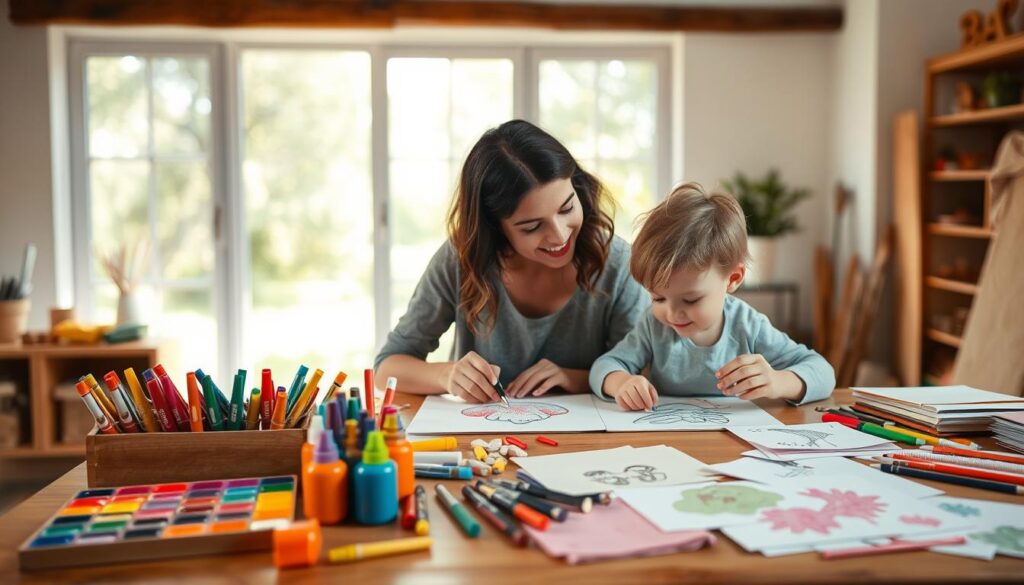
What makes a creative activity work for both toddlers and tweens? The answer lies in adaptable designs that grow with developing skills. A kindergarten teacher shared: “Our mixed-age sessions thrive when activities have built-in flexibility – everyone feels challenged without frustration.”
Tailoring Tasks to Developmental Stages
Younger kids excel with sensory-rich experiences. Think tracing shapes in sand or arranging sticker patterns. Older children tackle layered challenges like designing 3D paper sculptures. One key? Scalable instructions that let participants choose their complexity level.
Material choices matter across age groups:
- Preschoolers: Chunky crayons and tear-free paper
- Elementary students: Precision tools like blunt scissors
- Tweens: Digital apps with layering features
Mixed-age groups shine when activities encourage teamwork. Older kids often mentor younger ones – showing how to blend chalk colors or create shadow art. This builds leadership skills while keeping all engaged at their level.
Success looks different for each age. Celebrate a toddler’s bold scribbles as enthusiastically as a preteen’s detailed sketches. As one parent noted: “Watching siblings collaborate on leaf collages – each contributing their best skills – that’s the real masterpiece.”
Inspiring Art Activities for Young Children
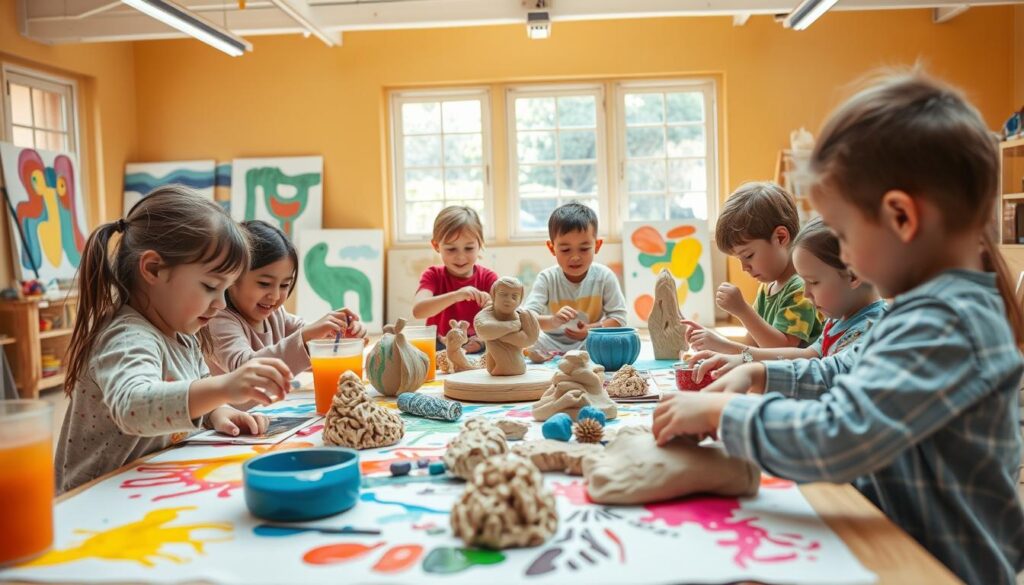
Have you ever watched a preschooler turn cardboard into a spaceship? This magic happens when we focus on creative journeys rather than polished results. Young minds thrive when given freedom to explore textures, colors, and shapes through hands-on discovery.
Hands-On Process Art
Process art lets kids dive into materials without strict rules. Think finger-painting with pudding instead of paint – it’s edible, washable, and teaches color mixing through squishy fun. Teachers love these activities because “mess becomes manageable when you’re using cornstarch clay instead of play-dough”.
Try offering varied textures:
- Crinkly foil for stamping patterns
- Soft yarn scraps for collage-making
- Cool gel bags for sensory drawing
These experiences build tactile awareness while letting children control their creations. A toddler might smear colors wildly, while an older sibling layers materials deliberately – both approaches matter equally.
Fostering Exploration Through Play
Play-based learning turns art into adventure. Hide stickers around the room for a “color hunt” collage. Challenge kids to arrange leaves by size before gluing them. One parent shared: “My 4-year-old now sees our backyard as an art supply store!”
Open-ended questions spark deeper thinking:
- “What sound does this crinkly paper make?”
- “How many ways can you bend this pipe cleaner?”
These activities teach cause-and-effect through joyful experimentation. When a chalk drawing washes away in rain, it becomes a science lesson about temporary art. Every discovery builds confidence and curiosity.
Exploring Digital and Paper Art Projects
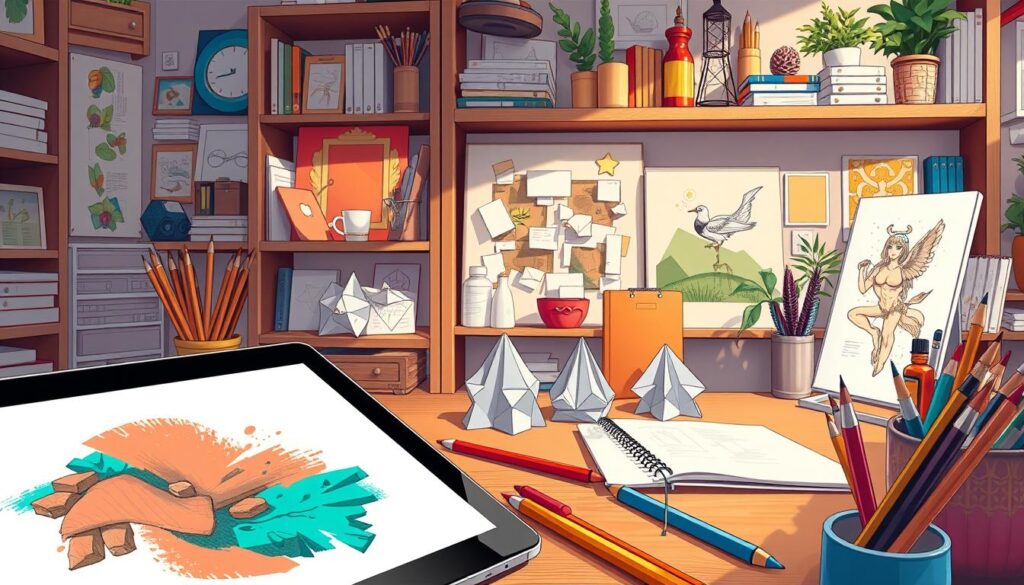
Creative expression meets modern solutions through two distinct paths: screens and sheets. These approaches let young creators experiment freely while keeping spaces tidy.
Digital Drawing and Design
Tools like Google Drawings turn tablets into portable studios. Kids mix colors using digital palettes and layer shapes without glue sticks. Undo buttons become safety nets, encouraging bold experiments. One teacher noted: “Students who fear mistakes thrive when they can revise endlessly.”
Paper-Based Craft Ideas
Transform ordinary sheets into 3D wonders through folding and cutting. Origami cranes teach geometry, while dictionary drawings merge literacy with visuals. Try this twist: illustrate unfamiliar words found on random pages.
| Activity Type | Skills Developed | Materials Needed |
|---|---|---|
| Digital Drawing | Color theory, tech literacy | Device + free app |
| Origami | Spatial reasoning, precision | Square paper |
| Dictionary Drawing | Vocabulary, illustration | Old book + pencils |
Both methods adapt seamlessly. Digital tools offer infinite colors; paper crafts build tactile skills. Rotate between them to maintain excitement. As one parent shared: “Our kitchen table hosts both laptops and origami swans – different mediums, same creativity.”
Art Projects for Classroom and Homeschool Settings
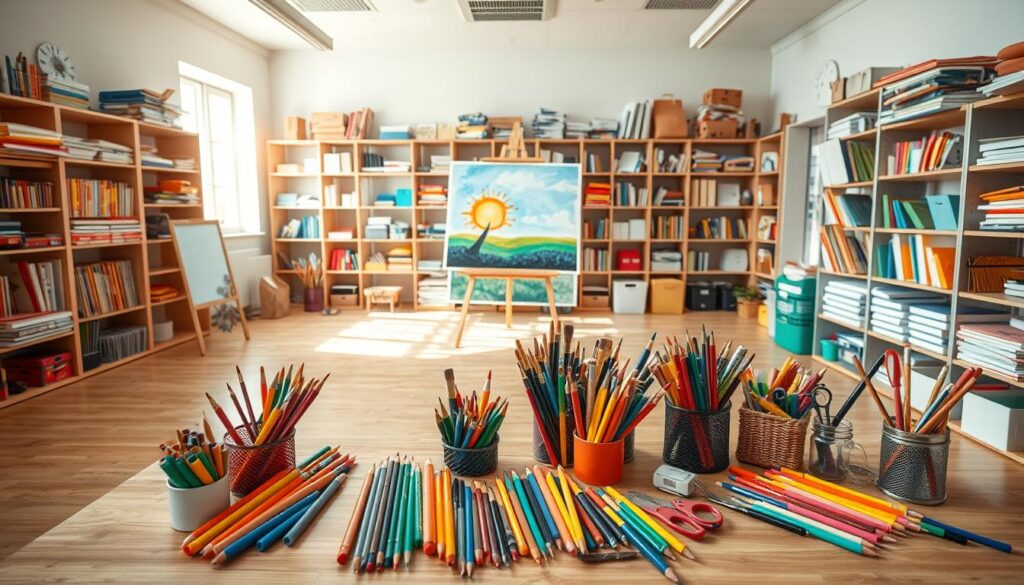
Seasoned educators know creativity flourishes within structure. Art With Trista’s 20-year classroom experience and Kids Art Projects 101’s research-backed units prove mess-free approaches work across grade levels. These methods transform ordinary spaces into vibrant learning labs – no sinks or specialty rooms required.
Integrating Curriculum and Creativity
Teachers report 40-minute guided sessions blend seamlessly with core subjects. A fifth-grade instructor shared: “We design Egyptian hieroglyphics during history units using salt dough tablets – zero cleanup, maximum engagement.” Digital presentations allow students to explore color theory while discussing science concepts like light refraction.
Three integration strategies work best:
- Math patterns through sticker mosaics
- Storyboarding literary scenes with collage elements
- Cultural studies via digital design apps
Art Teacher’s Perspective on Mess-Free Projects
Veteran educators emphasize time savings. “I reclaim 15 minutes per class,” notes a K-5 specialist. Prepped kits with washable markers and textured papers let students dive straight into art lessons. This efficiency matters most during hectic school year periods like standardized testing weeks.
New teachers benefit from ready-made resources. Guided video demos build confidence in educators without formal training. As one homeschool parent remarked: “The units helped me teach perspective drawing – something I’d never attempted before.”
Step-by-Step Guide to a Mess-Free Art Project
What if creating masterpieces didn’t require chaos? Let’s explore two popular activities – origami cranes and marble paper designs – that teach planning skills while keeping spaces tidy. Both methods use sequential learning to build confidence through clear milestones.
Materials Needed
Gather these basics in under two minutes:
- Origami: Square paper + video tutorial access
- Marble Paper: Shaving cream, liquid watercolors, ruler
One teacher’s tip: “Store supplies in labeled shoeboxes – kids grab what they need without rummaging.”
Execution Process
For marble paper:
- Fill a tray with shaving cream
- Dot with watercolors using eyedroppers
- Swirl gently with a pencil tip
- Press paper onto the surface
- Scrape off excess with a ruler
Encourage independence by displaying step photos. Kids check progress visually, reducing repeated questions.
Post-Task Reflection
Ask open-ended questions: “Which step felt trickiest?” or “How would you change the colors next time?” Document answers in journals with before/after photos. This practice turns single tasks into growth timelines.
Parents report: “Seeing their first crane beside the tenth one – that’s when kids grasp practice makes progress.” Reflection builds metacognition skills used in math and science too.
Integrating Art Education with Fun Challenges
Collaboration sparks creativity in ways solo tasks can’t match. When kids work together on mural designs or group collages, they learn to compromise and build on each other’s ideas. Friendly competition adds excitement – think timed color-mixing contests or pattern creation races using household items.
Competitive and Collaborative Tasks
Team challenges teach valuable life skills. Try dividing students into groups to create storyboard sequences with limited supplies. One class transformed old magazines into 3D cityscapes – each team responsible for different districts. The result? A lesson in urban planning and teamwork.
Individual contests with shared goals work too. A “color hunt” where participants find matching shades in nature encourages observation skills. Parents report: “Our backyard competitions turned color theory into an adventure!”
Balance is key. Pair collaborative efforts with low-stakes contests to nurture both sportsmanship and creative growth. Celebrate group wins and personal progress equally – every participant leaves feeling accomplished.
FAQ
How do mess-free activities encourage creativity without the chaos?
Can these projects really help kids build confidence?
What materials work best for minimal cleanup?
How can I adjust an activity for both toddlers and older children?
Are digital tools effective for developing traditional art skills?
What’s a simple way to add art to a homeschool routine?
How do collaborative tasks make learning more engaging?

Eduard Kingly is a travel and lifestyle content creator with a focus on personal development and education. He combines firsthand travel experiences with research-driven insights to guide readers in discovering new places, building better habits, and pursuing meaningful learning.

